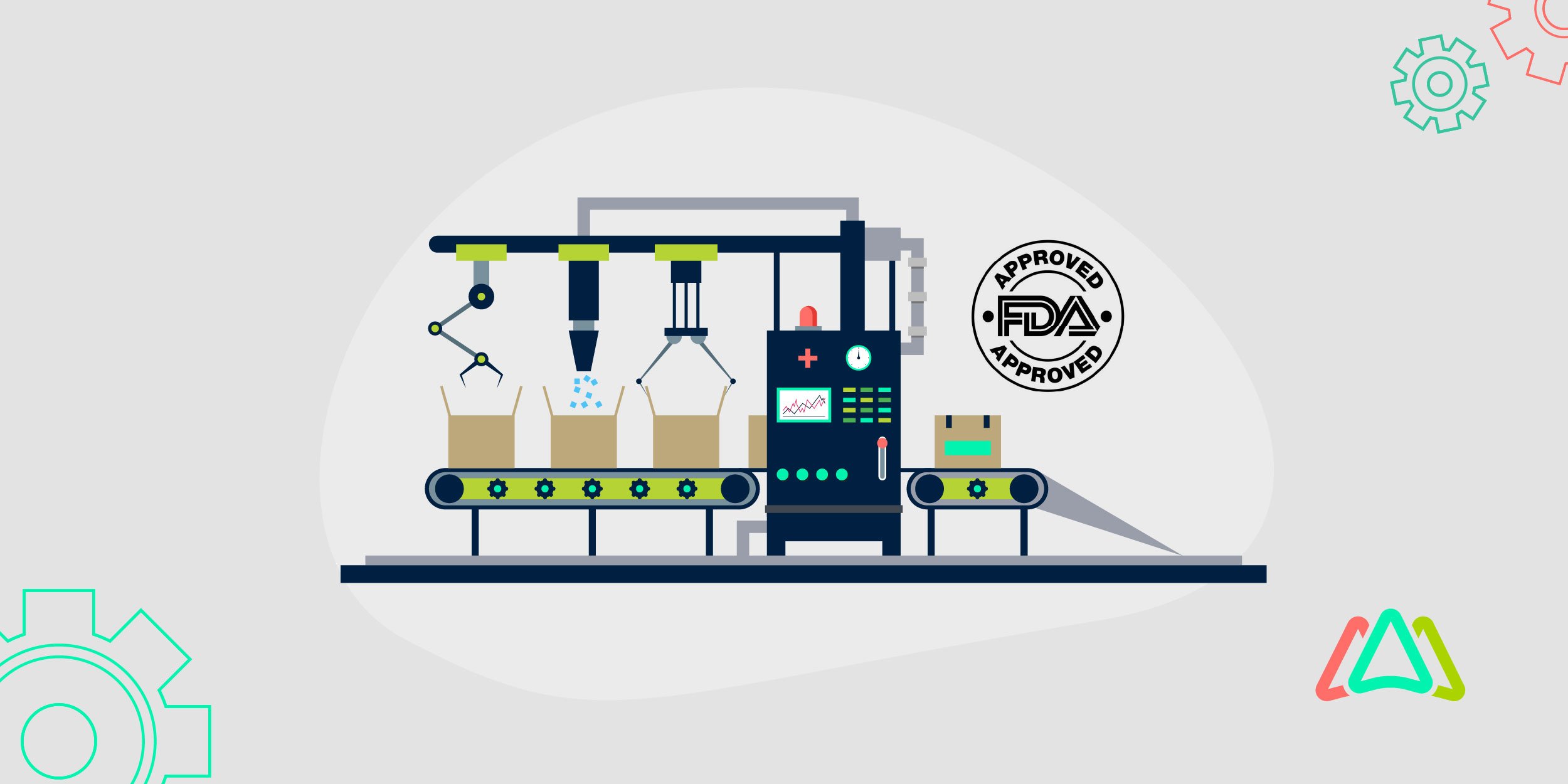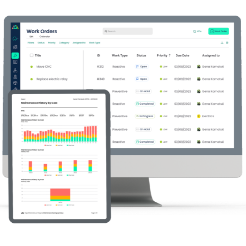
How to Comply with FDA Regulations Using a CMMS
In FDA-regulated industries such as pharmaceuticals, medical devices, biotechnology, and food manufacturing, compliance is not optional. The reason is simple; it’s a legal and operational necessity. The U.S. Food and Drug Administration (FDA) is a governing body that enforces strict standards to ensure that products are safe, effective, and consistently manufactured under sanitary and controlled conditions. Maintenance is a critical but sometimes overlooked aspect of this compliance. Equipment, facilities, and instruments must be routinely cleaned, inspected, calibrated, and repaired to meet Good Manufacturing Practice (GMP) requirements.

The FDA’s Code of Federal Regulations (CFR) outlines specific rules governing maintenance in regulated environments. For example, 21 CFR Part 211 addresses equipment maintenance and cleaning in pharmaceutical manufacturing, while 21 CFR Part 820 lays out similar expectations for the medical device industry. Additionally, 21 CFR Part 11 requires that electronic maintenance records and signatures meet stringent requirements for data integrity, traceability, and security. A failure to comply with any of these codes can lead to costly product recalls, warning letters, 483 inspection findings, or even facility shutdowns.
This is where a Computerized Maintenance Management System (CMMS Software) becomes indispensable. A CMMS helps regulated organizations automate maintenance scheduling, ensure accurate documentation, manage calibration tasks, and maintain audit-ready compliance records. Rather than relying on manual tracking or disconnected spreadsheets, a modern CMMS ensures that every maintenance task is planned, performed, and recorded in alignment with FDA expectations.
By digitizing and standardizing these workflows, a CMMS supports continuous compliance, improves operational efficiency, and reduces the risk of regulatory violations. In this article, we’ll explore what FDA regulations apply to maintenance, the CMMS features that facilitate compliance, and how to select the right system for your FDA-regulated facility.
CMMS Features that Support FDA Compliance
In FDA-regulated sectors, a CMMS is not just a maintenance scheduling tool; it is fundamental to achieving regulatory compliance. One of the most critical features is automated preventive maintenance (PM) scheduling. FDA regulations require that equipment and instruments be maintained and calibrated at appropriate intervals, and these tasks must be documented. A CMMS can automatically generate work orders based on time, usage, or condition-based triggers, ensuring that critical assets are serviced before they fall out of spec or become a compliance liability.
Another key feature is work order documentation and electronic recordkeeping. A robust CMMS captures detailed records for each maintenance task, including who performed the work, what was done, what parts were used, and when it occurred. This information forms a digital audit trail, essential for FDA inspections and compliance. Many modern CMMS platforms include secure access controls, electronic signature capabilities, and built-in audit logs, enabling organizations to meet the FDA’s expectations for data integrity, traceability, and accountability. These capabilities are particularly critical in environments where manual records are too risky or time-consuming to manage reliably.
A CMMS also helps ensure compliance with equipment calibration and validation requirements. Some CMMS systems offer modules specifically designed to schedule, track, and log calibration and qualification events. These tools enable maintenance teams to set alerts for upcoming calibration due dates, store certificates of calibration, and maintain historical records that are directly linked to each asset. This is notably valuable for medical device manufacturers and pharmaceutical companies, which must demonstrate that their equipment operates consistently and within tolerance limits as part of their FDA-mandated quality systems.
Additionally, a CMMS supports Standard Operating Procedure (SOP) enforcement by embedding SOPs and maintenance protocols directly within work orders. This ensures that technicians follow documented procedures every time, reducing the risk of human error and noncompliance. In this regard, some systems are designed to support checklists, required sign-offs, and photographic evidence, adding another layer of control and traceability. Combined with its reporting and dashboard features, organizations can easily generate compliance metrics, monitor maintenance backlogs, and identify trends that may signal underlying risks. Altogether, these CMMS features form a comprehensive compliance framework that supports FDA readiness while enhancing operational performance.
What to Look for in a CMMS for FDA-Regulated Industries
Selecting the right CMMS for a regulated FDA environment requires more than just comparing features; it also necessitates considering the specific compliance requirements that apply to this environment. Due to the stringent FDA requirements, the software must be designed and built to meet these requirements. First and foremost, the CMMS must support 21 CFR Part 11 compliance, which governs the use of electronic records and electronic signatures. This means the system must offer secure user access controls, audit trails, and electronic signature functionality that tie actions to specific users. Without these capabilities, electronic maintenance records may not be considered sufficient during an FDA inspection, leaving an organization exposed to regulatory risk.
Equally important is the CMMS’s ability to support calibration management and track equipment validation. In other words, the system should allow users to schedule recurring calibration events and log certificates of calibration and associate those records with specific equipment. For companies operating under 21 CFR Part 211 or Part 820 codes, these features are vital for demonstrating that equipment remains operational within defined performance specifications. Some CMMS platforms go a step further by offering tools to manage Installation Qualification (IQ), Operational Qualification (OQ), and Performance Qualification (PQ) documents. These documents are critical components of system validation and equipment commissioning in FDA-regulated environments.
Other key capabilities are workflow customization and SOP integration. To access this capability, the CMMS should have a feature that enables the direct embedding of Standard Operating Procedures into work orders. It will also allow users to enforce procedural steps through checklists, required sign-offs, and escalation triggers. This level of control ensures that maintenance is performed consistently and in accordance with documented procedures, which is essential for maintaining quality system compliance. Additionally, the CMMS should support flexible reporting tools to generate FDA-ready reports, including maintenance logs, calibration records, and asset history data. Dashboards that flag overdue tasks or highlight maintenance trends can also help identify compliance gaps before they become audit findings.
Lastly, consider the CMMS vendor’s experience with FDA-regulated customers and their ability to provide system validation documentation or support. Many FDA-regulated organizations are required to validate software systems as part of their inspection processes. A CMMS vendor well-versed in FDA regulations should be able to offer validation templates, risk assessments, or professional services for IQ/OQ/PQ activities. These features, as well as integration with other enterprise solutions, such as ERP, QMS, or document management platforms, can significantly streamline an organization’s software implementation and compliance efforts. In short, the noted CMMS capabilities are all intended to improve an organization’s audit readiness and reduce its regulatory burden.
Best Practices for CMMS Implementation in FDA-Inspected Facilities
Implementing a CMMS in an FDA-regulated environment requires a carefully planned approach that prioritizes both regulatory compliance and operational effectiveness. One of the first and most critical steps is to validate the CMMS software before it goes into operation. Validation demonstrates that the system performs as intended and produces accurate, reliable results when used as intended—a key requirement under 21 CFR Part 11. Many organizations follow the IQ/OQ/PQ model (Installation Qualification, Operational Qualification, and Performance Qualification) to formulate this validation process. As previously noted, choosing a vendor that provides validation documentation or assistance can significantly reduce the effort required by an IT team and ensure compliance from the outset.
Another best practice is to standardize and align all maintenance-related SOPs before integrating them into the CMMS. This includes preventive maintenance procedures, calibration protocols, equipment cleaning methods, and change control processes. When these SOPs are embedded into the CMMS workflow, they ensure consistency and minimize the risk of procedural errors. Standardization also enhances inspection readiness, as it provides direct links between written procedures and the actual work performed. Including step-by-step instructions, acceptance criteria, and required sign-offs in each work order facilitates procedural adherence and supports the traceability expected by FDA inspectors.
Training and change management are also essential components of a successful CMMS implementation. All users, from maintenance technicians to quality assurance staff, must be trained not only on how to use the system, but also on how its use enables regulatory compliance. This dual focus helps users understand the broader importance of accurate documentation, timely task completion, and proper use of electronic signatures. During FDA inspections, the quality of documentation is just as critical as the actual maintenance performed. For these reasons, user buy-in and training are essential to maintaining a compliant culture.
Ultimately, the goal is for organizations to utilize the CMMS as a means to facilitate continuous improvement and ensure readiness for inspections. To achieve this end, maintenance managers should conduct regular internal audits using CMMS data, track key performance indicators (KPIs) such as PM completion rates and overdue calibrations, and utilize these insights to drive corrective and preventive actions (CAPA). When it comes to regulatory compliance, the CMMS serves as a central repository for documentation needed during inspections or in response to FDA Form 483 observations. When implemented strategically, organizations will be well-prepared to reap the benefits that a CMMS has to offer.
Conclusion
In FDA-regulated industries, maintenance involves more than just serving a technical function. A correctly implemented CMMS provides the structure, documentation, and control necessary to comply with FDA requirements related to equipment maintenance, calibration, and electronic recordkeeping. It does this by automating preventive maintenance schedules, ensuring data integrity, and generating audit trails and electronic signatures. A CMMS with its robust features helps organizations stay inspection-ready while reducing risk and improving operational reliability.
By aligning a CMMS with key FDA regulations, such as 21 CFR Part 11, Part 211, and Part 820, and following best practices like system validation and SOP integration, organizations can transform compliance from a reactive chore into a proactive, integrated process. The right CMMS can become a strategic asset that supports quality assurance, continuous improvement, and regulatory confidence.
TABLE OF CONTENTS
Keep Reading
Spare parts management within maintenance can make the difference between a problem-free ...
16 Dec 2025
Every maintenance team eventually faces the same question: When should we repair, and when ...
12 Dec 2025
Enterprise Asset Management (EAM) software has become a cornerstone for organizations aiming ...
12 Dec 2025
Unexpected equipment breakdowns can disrupt operations, increase repair costs, and reduce ...
11 Dec 2025
Businesses are always looking for ways to improve efficiencies, reduce costs, and improve ...
9 Dec 2025
The longest U.S. federal government shutdown to date lasted 43 days, beginning on October 1, ...
5 Dec 2025
Every maintenance professional faces it sooner or later — that critical time when an aging ...
18 Nov 2025
The term 'best' is often used loosely, without a clear understanding of its context or ...
14 Nov 2025
In the not too distant past, maintenance strategies have been defined by reaction—fixing ...
13 Nov 2025
Tax season is the time of year that often sends a ripple of anxiety through many of us. The ...
11 Nov 2025
Selecting a Computerized Maintenance Management System (CMMS) can, at first glance, be an ...
4 Nov 2025
In healthcare facilities, equipment uptime involves more than achieving operational ...
31 Oct 2025
Companies are subject to economic ups and downs, also known as economic volatility. Today, ...
30 Oct 2025
Maintenance challenges are a constant struggle, with unplanned downtime costing manufacturers ...
27 Oct 2025
Last winter, a maintenance technician at a U.S. paper mill ignored a predictive alert that ...
10 Oct 2025
Many organizations proudly say they “have a CMMS,” but ownership alone doesn’t equal ...
9 Oct 2025
Every maintenance team is under pressure to do more with less. Unplanned downtime is often ...
7 Oct 2025
The implementation of simple, yet powerfully effective, checklists has repeatedly ...
3 Oct 2025
In manufacturing, every second counts. When production stops, whether due to scheduled ...
2 Oct 2025
The increasing cost of maintenance, lack of accountability, and siloed systems leave many ...
30 Sep 2025






